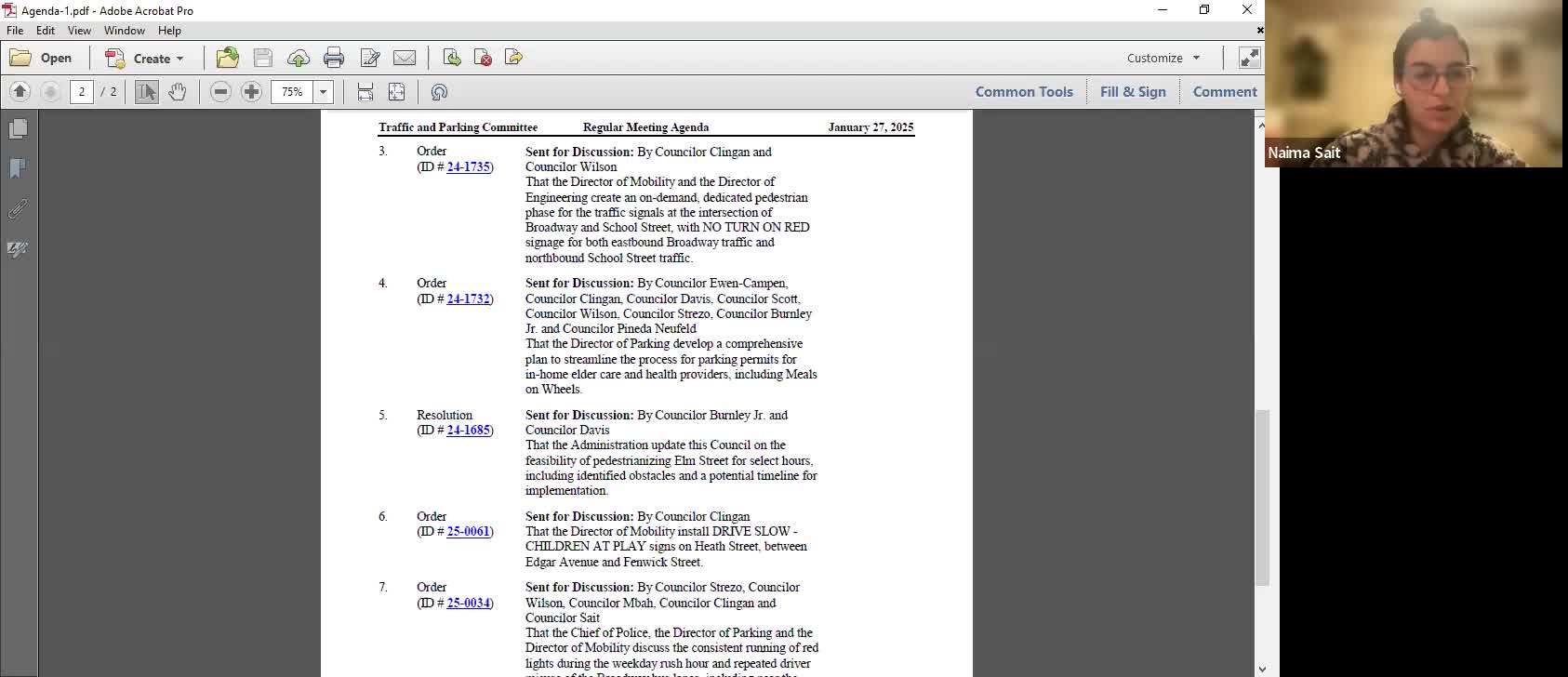Somerville staff outline barriers to pedestrianizing Elm Street for limited hours; modeling and community engagement needed
January 28, 2025 | Somerville City, Middlesex County, Massachusetts
This article was created by AI summarizing key points discussed. AI makes mistakes, so for full details and context, please refer to the video of the full meeting. Please report any errors so we can fix them. Report an error »

An order requested the administration update the council on the feasibility of pedestrianizing Elm Street for select hours, including obstacles and a potential timeline.
Director Lawson summarized staff thinking and flagged multiple operational and network constraints. Staff said MBTA buses and eastbound motor vehicle traffic would need routing alternatives during pedestrianized hours; that likely requires converting at least short stretches of Highland Avenue to two‑way motor vehicle and bus travel or reconfiguring adjacent streets such as Cutter or Grove. Lawson said those sorts of network changes require modeling, design, signal adjustments and public outreach.
Lawson also stressed delivery logistics and the needs of small businesses and property owners: pedestrianization can shift loading trips onto nearby streets and may require time‑limited delivery windows or other mitigation. Staff said physical modifications — curb extensions, signal adjustments and possible conversion of a parallel block to two‑way traffic — could take substantial design time and construction funds.
Councilor Hasla Burnley and others emphasized using temporary tests (extended events, festivals or ‘honk fests’) to pilot pedestrianization and asked staff for a short feasibility memo outlining barriers and scope. Lawson said staff will prepare an initial, limited scope feasibility summary within a few months to identify the questions that require more extensive modeling or capital work, and noted staff resources are constrained but that the mayor supports the priority.
Committee members also raised safety concerns on nearby Highland Avenue — staff and councilors said Highland shows a “double‑threat” crash exposure (two same‑direction travel lanes where a stopped car can be masked by a second lane) and that modifications to Highland are a likely component of any Elm Street pedestrianization approach. No final decision was made; staff will return with an initial feasibility memo and possible pilot concepts.
Director Lawson summarized staff thinking and flagged multiple operational and network constraints. Staff said MBTA buses and eastbound motor vehicle traffic would need routing alternatives during pedestrianized hours; that likely requires converting at least short stretches of Highland Avenue to two‑way motor vehicle and bus travel or reconfiguring adjacent streets such as Cutter or Grove. Lawson said those sorts of network changes require modeling, design, signal adjustments and public outreach.
Lawson also stressed delivery logistics and the needs of small businesses and property owners: pedestrianization can shift loading trips onto nearby streets and may require time‑limited delivery windows or other mitigation. Staff said physical modifications — curb extensions, signal adjustments and possible conversion of a parallel block to two‑way traffic — could take substantial design time and construction funds.
Councilor Hasla Burnley and others emphasized using temporary tests (extended events, festivals or ‘honk fests’) to pilot pedestrianization and asked staff for a short feasibility memo outlining barriers and scope. Lawson said staff will prepare an initial, limited scope feasibility summary within a few months to identify the questions that require more extensive modeling or capital work, and noted staff resources are constrained but that the mayor supports the priority.
Committee members also raised safety concerns on nearby Highland Avenue — staff and councilors said Highland shows a “double‑threat” crash exposure (two same‑direction travel lanes where a stopped car can be masked by a second lane) and that modifications to Highland are a likely component of any Elm Street pedestrianization approach. No final decision was made; staff will return with an initial feasibility memo and possible pilot concepts.
View full meeting
This article is based on a recent meeting—watch the full video and explore the complete transcript for deeper insights into the discussion.
View full meeting
